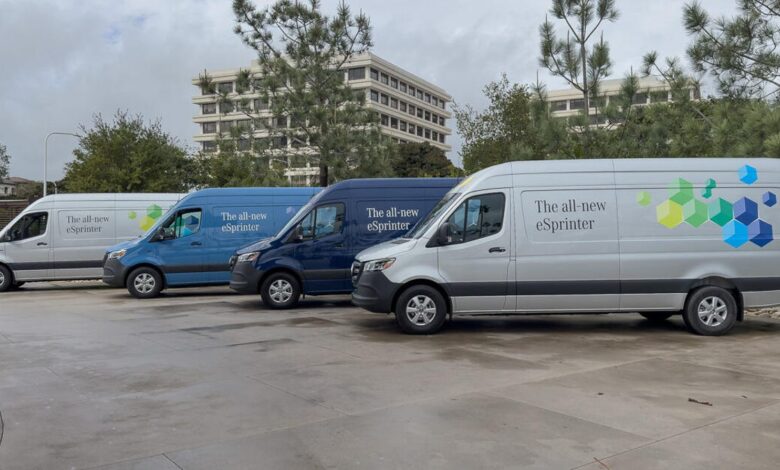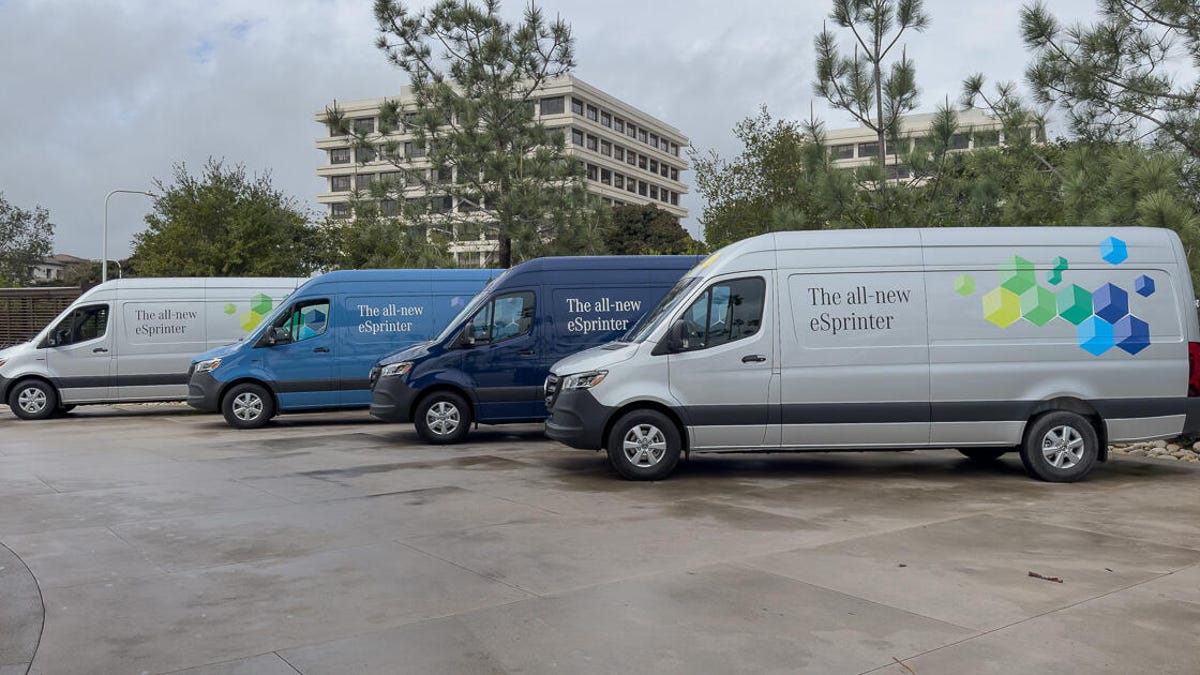Electric Mercedes-Benz eSprinter: A Small Step for Van, a Giant Leap for Van-Kind


Mercedes-Benz’s big Sprinter van can be many things — a delivery van, a service vehicle, sometimes even a home for well-heeled #vanlifers — and today, it can be all of that and all-electric with the arrival of the 2024 Mercedes-Benz eSprinter. And while neither the specs nor the performance are exactly neck-snappers for folks familiar with EVs, the eSprinter’s intended purpose as an electric commercial and fleet vehicle comes with slightly different expectations than passenger cars.
In this commercial van class, efficiency, operating costs and reliability reign supreme, and the eSprinter’s electric powertrain promises advantages in each of these categories that make it a better choice for dense urban environments than its diesel-powered counterparts.
Price and availability
The 2024 Mercedes-Benz eSprinter is available for order now with a single long-wheelbase, high-roof cargo body configuration and two motor options. The standard 100-kilowatt variant starts at $74,181, while the “high-output” 150-kW motor steps up to $77,611. Both prices include the requisite $2,295 destination fee, but not expensive options present on the vehicles I tested such as Premium MBUX infotainment, a navigation and charging speed upgrade package and more. Check the right boxes and this could easily become an $80K+ electric cargo van.
None of Mercedes’ EVs currently qualify for the full or partial federal EV tax credit, and the eSprinter doesn’t change that despite being built in the US at MB’s South Carolina plant and starting below the price cap for electric vans, trucks and SUVs.
Modest performance, excellent range
If you’re wondering why the quotation marks around “high-output” earlier, it’s because 150 kW works out to only around 201 horsepower driving the rear wheels. Meanwhile, the 100-kW motor’s standard output converts to just 134 hp. Regardless of standard- or high-output, all eSprinters feature the same peak 295 pound-feet of torque with the same 2,624-pound payload, 4,277-pound towing capability and 488.1 cubic-foot cargo volume.
For comparison, the diesel-powered Sprinter rolls out with standard-output (170 hp, 295 lb-ft) and high-output (211 hp, 332 lb-ft) engines in roughly the same ballpark, but the way the EV delivers its power is different from the diesels. For starters, the EV can maintain its 295 lb-ft torque peak for only around 30 seconds before dropping down to a lesser (and unstated) torque figure. The diesels can stay in their peak powerband for longer, but require nine-speed transmissions to do so. The EV’s single-speed, no-shifting setup delivers smoother and quieter acceleration under light-to-moderate loads.
The eSprinter’s lithium iron phosphate (LFP) battery is new to Mercedes’ portfolio and noteworthy in that it requires no cobalt and no nickel in its construction, making it more resistant to thermal runaway and less expensive to produce. The battery’s 113 kilowatt-hours of usable capacity nets the electric van an estimated 273 miles of range on Europe’s WLTP test cycle — a number that will likely shrink a bit once subjected North American driving habits. (My example estimated a 228-mile maximum range on its trip computer when departing with a 98% charge, but that’s not exactly a reliable metric.)
To help drivers balance range and performance, the eSprinter features three drive modes (comfort, eco and maximum range) that adjust the accelerator response and climate control system. Four manual recuperation modes are selectable via paddles shifters on the steering wheel, ranging from full coasting on accelerator lift (D++) to full regenerative braking (D-). There’s also D AUTO, which automatically adjusts the regen level for you based on conditions and traffic.
The eSprinter’s charging port is positioned at the center of the grille (like Nissan’s Leaf), which I think is the ideal location.
Charging speed
Charging the eSprinter at a 9.6-kW AC wall charger takes about 12.5 hours from flat to full. On the go, it can reach up to 50 kW at a DC fast charger, going from 10% to 80% full in around 93 minutes. That’s far from the fastest charging EV to hit the market, but I’m not going to complain too loudly given the eSprinter’s intended use as an urban utility vehicle may not require frequent fast charges or long trips. Drivers needing to juice up quickly can unlock up to 115-kW DC charging — part of $3,819 worth of tech package options — sprinting to 80% in around 42 minutes, which is shorter than a lunch break.
The van’s combined charging system (CCS) port can be found front and center behind the Mercedes’ large three-point star badge. I think that this is the best position for nose-in charging as it’s agnostic of which side the pedestal is on and requires less awkward stretching of charging cables. I wish more EV designers would put their ports here.
Slow and steady wins the (efficiency) race
As expected based on the specs, the eSprinter’s acceleration isn’t amazing. Loaded up with just a 200-something-pound driver and a 440-pound payload (nowhere near the stated 2,624-pound max), the 150-kW variant felt borderline underpowered when asked to climb the steeper hills around the Southern California testing area. Add to that a modest top speed of only 75 mph and highway driving also becomes an exercise in patience. Fortunately, I’m a very patient driver.
Mercedes tells me that cargo volume is more important than payload for most delivery drivers, which is why these eSprinters are only loaded with 440-pounds of their 2,624-pound max.
Around town and on flatter roads, the EV’s smoothness and silent operation outweighed the lack of power and, even more, I appreciated the energy efficiency of the eSprinter. I averaged 2.0 miles per kilowatt-hour, which works out to around 67.4 mpg equivalent, on my first 82-mile leg of testing while still getting used to the van. Later in the day, with a better idea of what to expect, I got up to 2.3 milies per kWh (the gasoline equivalent of 77.5 mpg) over a shorter but still hilly 33-mile loop. Doing so required switching into the painfully slow Max Range mode, but compared with the 17.3 mpg average reported by diesel Sprinter drivers on fuelly.com and with electricity being less expensive per mile than gas (PDF), I’d say it’s worth taking it a little slow to potentially save a lot of money. Plus, there’s no fuel efficiency penalty in any mode for the frequent stops, stop-and-go traffic or idling typically encountered by delivery drivers.
Smart features and technology
The eSprinter is available with the latest generation of the Mercedes-Benz User Experience (MBUX) infotainment with up to a 10.25-inch touchscreen and the same smartly organized software that you’ll find in Benz’s passenger cars from the CLA to the EQS. That means smart navigation that takes range and charging stops into account when choosing routes, support for wireless Apple CarPlay and Android Auto and the excellent “Hey Mercedes” voice command system. I was able to make use of the latter to simply ask the car to turn on the seat heaters when I was unable to find the physical controls.
The MBUX navigation loads charging stations (with availability) along with map data. The white highlighted area indicates how far you can go on a single charge.
My example also featured a trio of USB-C ports in the cubby atop the dashboard (one for data and two for charging devices) and a digital rearview mirror that transforms the center mirror into a display fed by a high-mount rear camera at the flip of a switch. This greatly improved rear visibility and safety, especially on my example equipped with a solid bulkhead between the cabin and cargo areas that rendered the optical mirror completely useless.
However, all of the options and packages start to add up. After taking stock of the upgrades on my example, I found a little over $10,000 in optional equipment, bringing my eSprinter High-Output to an estimated as-tested price of around $86,201.
Pros and cons of the 2024 Mercedes-Benz eSprinter
The 2024 Mercedes-Benz eSprinter proved to be much more energy efficient than its diesel-powered stablemates with decent EV range for a big ol’ commercial van. I loved how quiet it was and how the advanced safety features and electric powertrain make such a large vehicle easy to drive. While the charging speeds are nothing to brag about, I think the eSprinter charges fast enough for its intended use.
The eSprinter would be great for city van uses like redistributing rideshare bikes, last-mile delivery, mobile service or roadside assistance.
That said, the performance, especially on highways and hills, leaves a bit to be desired. The low top speed and DC charging rate aren’t dealbreakers, but they’re limitations that conspire to discourage long-distance hauls. Despite the potential for lower operating costs over the EV’s lifetime, it’s also impossible to ignore the eSprinter’s upfront cost is around $15,000 more than a comparable diesel Sprinter. That said, the eSprinter is less expensive than Rivian’s Commercial Van, which starts at around $83,000, making it a more tempting choice for businesses itching to integrate electric vehicles into their fleets.
Currently, the eSprinter feels like a good compliment to the conventional Sprinter, and I’m excited about its potential applications. I can see fleet operators adding the electric van into their motor pools alongside combustion vehicles to improve average efficiency operating costs across the fleet. There’s also the lower maintenance costs of EVs to consider, which is bolstered by Mercedes’ warranty covering four years (or 100,000 miles) of maintenance and guaranteeing less than 30% battery degradation for the first eight years (or 100,000 miles.) This strategy would see the EV used for urban service and last mile delivery where its advantages can shine, while sticking with a mix of petroleum-powered vans for longer hauls and hilly rural routes where the eSprinter’s performance, for now, seems to still suffer.
What’s next from MB vans?
With the eSprinter high-roof cargo van rolling out, I hope we’ll see more configurations getting the electrified treatment. European markets will get eSprinter versions with the standard roof and the shorter wheelbase. Perhaps demand will bring these eSprinter cargo van variants or even a passenger van to North America.
Meanwhile, Mercedes-Benz Vans has announced that its upcoming electric vehicle platform, dubbed VAN.EA, will arrive in 2026. VAN.EA will eventually underpin the next-generation of MB electric vans from luxury passenger vans to a replacement for the recently discontinued mid-size Metris to the next-generation of the eSprinter by 2030.
Editors’ note: Travel costs related to this story were covered by the manufacturer, which is common in the auto industry. The judgments and opinions of CNET’s staff are our own and we do not accept paid editorial content.




